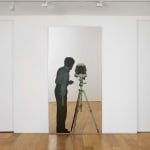


Michelangelo Pistoletto 1901-1986
Un Fotografo (A Photographer), 1962-80
Silkscreen on stainless steel
250.5 x 125 cm. (98 5/8 x 49 1/4 in.)
Copyright The Artist


